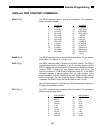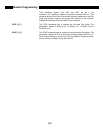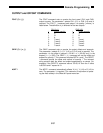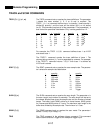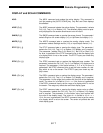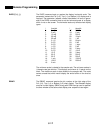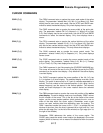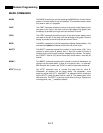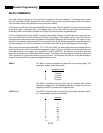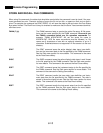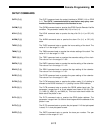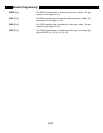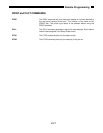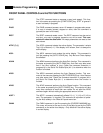
6-15
Remote Programming
AUX INPUT and OUTPUT COMMANDS
OAUX? i The OAUX? command queries the Aux Input values. The parameter i
selects an Aux Input (1, 2, 3 or 4) and is required. The Aux Input voltages
are returned as ASCII strings with units of Volts. The resolution is
1/3 mV. This command is a query only command.
AUXM (?) i {, j} The AUXM command sets or queries the Aux Output mode. The parame-
ter i selects an Aux Output (1, 2, 3 or 4) and is required. The parameter j
selects Fixed (j=0), Log sweep (j=1) or Linear sweep (j=2).
AUXV (?) i {, x} The AUXV command sets or queries the Aux Output voltage when the
output is in fixed voltage mode. The parameter i selects an Aux Output
(1, 2, 3 or 4) and is required. If i selects an output which is set to sweep,
then the AUXV command will generate an error. The parameter x is the
output voltage (real number of Volts) and is limited to
-10.500 ≤ x ≤ 10.500. The output voltage will be set to the nearest mV.
SAUX (?) i {, x, y, z} The SAUX command sets or queries the Aux Output sweep limits and
offsets. The parameter i selects an Aux Output (1, 2, 3 or 4) and is
required. If i selects an output which is set to fixed voltage mode, then
the SAUX command will generate an error. The parameter x is the
sweep start voltage. The parameter y is the sweep stop voltage. The
parameter z is the sweep offset voltage. The parameters x, y and z are
real numbers of Volts. The values of x and y are limited to
0.001 ≤ x,y ≤ 21.000. The value of z is limited to -10.500 ≤ z ≤ 10.500.
The voltages will be set to the nearest mV.
The SAUX? i query will return x,y,z if the output is in a sweep mode. The
return string is in ASCII and multiple parameters are separated by
commas. For example, the SAUX?1 command returns
"3.456,7.890,0.000" if output 1 is sweeping from 3.456V to 7.890V with
0.000V offset.
Any set of sweep parameters which would result in an output voltage out-
side of the -10.5V≤V≤10.5V range results in an error.
TSTR (?) {i} The TSTR command sets or queries the trigger start scan mode. The
parameter i selects No (i=0) or Yes (i=1).



